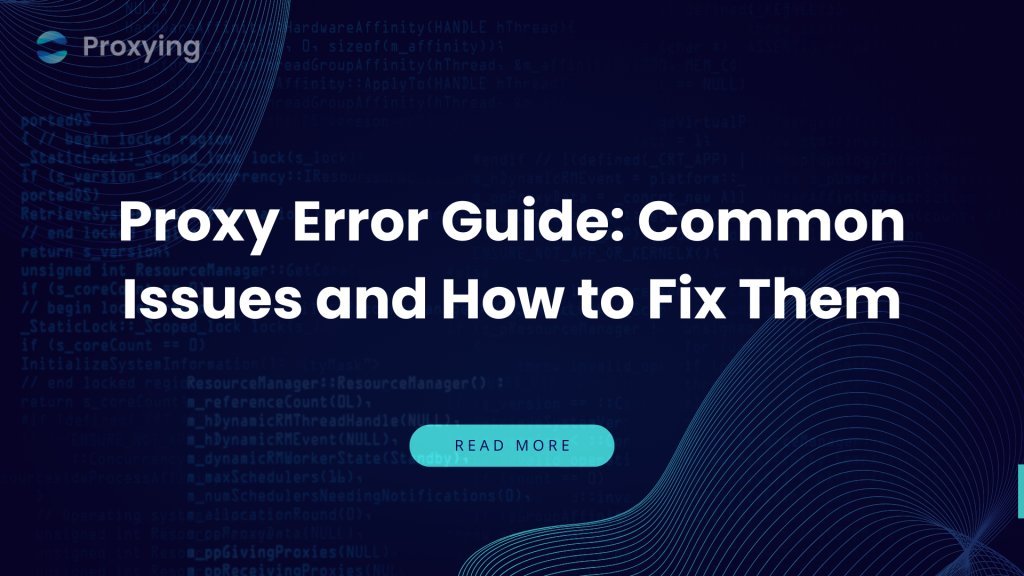It is certain to hit a proxy error when working with proxies, automating a scraping task, or accessing geo-blocked media. Whether it’s 403s or 407s or timeout errors, these problems can break your workflow and affect data quality.
In this blog, we will cover common proxy mistakes, reasons behind them, and how to fix or correct them, especially at scale. We will also show how Proxying.io makes the life of a developer and the business easier in terms of managing proxies.
What is a Proxy Error?
A proxy error takes place when one of the servers or clients fails to communicate correctly via a proxy server. These errors almost always also contain HTTP status codes (e.g. 404, 403, 407), and may be caused by misconfiguration, blocked IPs, expired credentials or network failures.
Proxies take the position of a middle person between your client and the internet. When one end of this chain fails to respond as would be expected, an error kicks in.
Common Types of Proxy Errors
Let’s break down some of the most frequent proxy errors and what they mean:
400 Bad Request
The server suspects your request to be malformed. It may occur when the proxy is changing requests inappropriately or you are transferring incorrect data. This is called Bad Request.
How to fix:
- Inspect the request URL, headers, and parameters.
- See to it that you are sending the right Content-Type of your POST requests.
- It is during the cookie or payload shopping that unneeded cookies or damaged cookies must never be sent.
401 Unauthorized
This is an error that takes place when the server demands user authentication, yet none or the wrong credentials are supplied.
How to fix:
- Be sure you use the right credentials.
- When you’re scraping, see whether the site needs logon.
- Properly deal with sessions and cookies.
403 CAPTCHA Block
On occasion, the websites will send back a 403 or the like that delivers a CAPTCHA page, particularly when we employ proxies aggressively.
How to fix:
- Reduce the rate at which you are requesting.
- Act through proxies that support high trust score (such as residential or mobile).
403 Forbidden
Probably the frequent meaning of this error is that the server refuses to accept accesses. It can track whether you are using a proxy or your IP address may be blacklisted because of being suspicious or scraping.
How to fix:
- Frequently rotate proxies.
- Apply residential/ mobile proxies.
- Simulate any real browsers using headers.
407 Proxy Authentication Required
Your proxy server uses authentication, and the supplied credentials (should there be one) are either incorrect or nonexistent.
How to fix:
- Verify the username as well as the password.
- Check the proxy set up of your code or browser.
- Make sure that the proxy server in question allows authentication of the protocol you are using.
429 Too Many Requests
You make too many requests within a narrow amount of time, and this is marked as abusive usage.
How to fix:
- Add request throttling and delays.
- Get rotating proxies, user agents.
- Obey the rate limits of scraping publicly available data.
502 Bad Gateway
It happens when the proxy server receives an inappropriate reply from the origin server.
How to fix:
- Repeat with a few seconds delay.
- Use an alternative proxy node.
- Ensure that the destination server is on.
504 Gateway Timeout
This server failed to reply on time. This may be because of a slow proxy, network congestion or an unresponsive destination server.
How to fix:
- Set greater timeout levels in your script.
- Try a different (and more stable) proxy provider.
- Make use of exponential backoff retry.
599 Network Connect Timeout
It is not a usual code of an error that those are the times when the client connects to the proxy.
How to fix:
- Make sure that your proxy is connected.
- Use an alternative proxy or endpoint.
- You need to increase your code connection timeout.
How Proxying.io Helps You Avoid Proxy Errors
The major causes of proxy errors are low infrastructure, low-quality IPs, or insufficient automation. With us at Proxying.io, these are solved with:
- Higher quality residential and mobile proxies with diminished chances of getting blocked.
- Location targeting based on automatic IP rotation to minimize the chances of detection.
- Good authentication support, IP whitelist authentication, and a username/password log-in feature, available.
- Verbose error logs and assistance, hence enabling you to fix matters rapidly.
- Fast failover where the request that has failed is retried with different IP addresses.
By using Proxying.io, you not only reduce the frequency of proxy errors but also gain insights into what’s causing them, letting you act quickly and keep your data pipelines running smoothly.
Best Practices to Avoid Proxy Errors
Here are a few golden rules to minimize proxy-related issues:
- Choose residential proxies or mobile proxies over data center proxies.
- The throttle requests are made to emulate the human browsing time.
- The application randomizes headers and user agents to prevent the detection.
- Keep a track of the proxy performance and rotate underperforming IPs.
- Select a proxy provider that has a demonstrated track record of uptime and support such as Proxying.io.
Conclusion
Encountering a proxy error is a common but solvable challenge. By understanding the different types of errors and applying the right fixes, from rotating IPs to adjusting headers, you can build more reliable scraping and automation systems.




